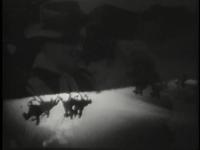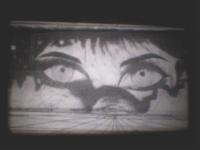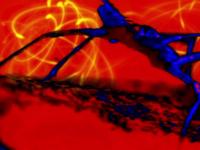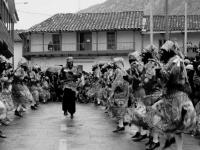Available online worldwide!Thursday October 8, 2020, 7:00 pm CDT / 5:00 pm PDTWNDX and Los Angeles Filmforum presentIsm, Ism, Ism: Umbrales: Experimental Women Filmmakers from Latin America
Online via WNDX Festival of Moving Image, www.wndx.org
Live conversation after the screening moderated by Mujer Artista, with Co-Curator Jesse Lerner and filmmakers Silvia Gruner, Poli Marichal, and Cecilia Vicuña.
Tickets: Free!
Livestream event, happening one time only.
More information, and to view the streaming show: www.wndx.org
(323) 377-7238
This program showcases female filmmakers who sought to carve out a place within the male-dominated world of Latin American independent audiovisual production. Key works, such as Argentine filmmaker Narcisa Hirsch’s Taller (Workshop)(1975), exemplify the defiant position toward gendered and essentializing aesthetics expected of Latin American women filmmakers. This program includes pioneering Uruguayan filmmaker Lydia García Millán’s Color (1955), one of the first abstract experimental films from Latin America; the politically charged Super 8 experiments by Puerto Rican underground artist Poli Marichal; and recent video essays by Mexican artist Ximena Cuevas. Curated by Ángela López Ruiz.
Promotional Support for these online screenings from Experiments in Cinema, Albuquerque; Lightbox Film Center, University of the Arts, Philadelphia; Berkeley Art Museum * Pacific Film Archive, Berkeley.
Screening:
- Come Out, Narcisa Hirsch, 1971, 11 min, Super 8 transferred to digital, Argentina
The experimental filmmaker Narcisa Hirsch was born in Berlin in 1928 and moved to Argentina before the beginning of World War II. After a short-lived career as a painter, which included shows at the well-respected Galería Lirolay in Buenos Aires, Hirsch began organizing art happenings in 1967. The first, Marabunta (Swarm), entailed a larger-than-life-size skeleton of a woman covered with food and stuffed with live pigeons painted in neon colors. After 1967 Hirsch began shooting in 16mm and 8mm film and started meeting with a group of other young experimental filmmakers that included Alemann, Claudio Caldini (b. 1951), and Horacio Vallereggio (b. 1945). Unable to show their films in traditional theaters or museums, the group presented their work in small venues or at the Instituto Goethe, a space receptive to their experimental work. The transition from film to video at the beginning of the 1980s was the main reason for the dispersal of the group.
Hirsch's extended body of work includes Come Out (1971), Diarios patagónicos 1 (Patagonian diaries 1, 1972–73), Taller (Studio, 1975), Testamento y vida interior (Testament and inner life, 1977), Homecoming (1978), Ama-zona (The Amazon/ Love zone, 1983), A-Dios (Goodbye/To God, 1989), Rumi (1999), Aleph (2005), and El mito de Narciso (The myth of Narcissus, 2011). Parallel to her filmmaking career, Hirsch has taken up other forms of art. In the late 1970s, in the midst of the military dictatorship in Argentina, she covered public walls with phrases that sought to politicize the city. Later, in the 1990s and 2000s, Hirsch penned several books that were published in Argentina, such as La pasión según San Juan: Poema a partir de un guión cinematográfico (1992). Specializing in experimental film and video, the publishing house mQ2* in 2013 published a boxed set of Hirsch's experimental films from 1971 to 2011 and a bilingual book about her work with writings by Victoria Sayago, Emilio Bernini, and Hirsch.— Marcela Guerrero
- Color, Lydia Garcia, 1955, color, sound, Uruguay
Shot when García was still a teen, one of the first abstract experimental films out of Latin America. The soundtrack of García’s film features a performance recorded at Montevideo’s Hot Jazz Club.
- Desnudo con alcatraces, Silvia Gruner, 1986, 1:50 min, Super 8mm, b/w, silent, Mexico
- Popsicles, Gloria Camiruaga, 1982-1984, 4:42 min, video, USA-Chile
- Umbrales, Marie Louise Alemann, 1967, 19 min, color, 16mm, Argentina
Restored by Los Angeles Filmforum and the Academy Film Archive.
Marie Louise Alemann was born in 1927 in North Rhine-Westphalia, Germany. As a result of the Second World War, her family fled to Czechoslovakia. She made her way to Buenos Aires in 1949, where she lived until her death in 2015. Her activity was oriented towards a variety of fields, including photography, film, and journalism. Alemann's artistic career began in the headquarters of the Goethe Institute of Buenos Aires, where she integrated, with other creators, the group Cine Experimental Argentino.
- Paracas, Cecilia Vicuña, 1983, 18:26 min, color, sound, 16mm transferred to digital, USA/Chile
A three-dimensional animation of a pre Columbian textile. The Paracas textile, 300-100 BC, was found in a tomb in the south coast desert of Perú, and is a part of the collection of The Brooklyn Museum in New York.
- Devil in the Flesh (El Diablo en la Piel), Ximena Cuevas, 1998, 5 min, B&W and Color, Stereo, Mexico
"The palms of Lana Turner's hands were full of scars; the technique she used in order to achieve melodrama was to tighten her fists, digging her fingernails into them until she began to cry. Day after day, soap opera actresses smear Vick's Vaporub into their eyes in order to cry. The effect of these false tears are the tears of the public. In Devil in the Flesh we see the camera's tricks, and even so the action seems dramatic. This piece once again exemplifies my fascination with the artificial: the fabricated emotions; the Christian looking for pain in order to live out Passion; the discomfort of the everyday melodrama; the emptiness that defeats everything. So, as in all my work, I am obsessed with lying's various disguises. It doesn't interest me to watch that which is not hidden. Formally, my camera documents—looking directly without shame. The possibility of the narrative levels intrigues me in the montage. My camera work is cinema verite, and my montage work cinema mentira. My intent is an emotionally borderless language.
“In Devil in the Flesh, I look at myself in the mirror, but through the desolate hole of a mask, the circle is broken by the sharp biting angle of a telephone that keeps ringing. I take up the spoon again. There is no form of escape from everyday boredom. Every grammatical punctuation constitutes a search for a break in reality or an intensified state." —Ximena Cuevas, 1999
- Copacabana Beach, Vivian Ostrovsky, 1983, 10:08 min., Super 8 transferred to digital, color, sound, Brazil
A humorous glimpse at what happens every morning on the wavy sidewalks of Copacabana beach. Physical fitness Brazilian style, with a dash of soccer and hints of Carmen Miranda.
- Blues Tropical, Poli Marichal, 1982, 3:30, color, sound, Super 8 transferred to digital, Puerto Rico
Marichal’s explicitly anti-imperialist films Blues Tropical and Landscape (both completed in 1982) use the physical intervention on the emulsion of found footage as a metaphor to capture a sense of rage directed at the USA and its colonial presence in Puerto Rico.
This screening is part of Los Angeles Filmforum’s screening series Ism, Ism, Ism: Experimental Cinema in Latin America (Ismo, Ismo, Ismo: Cine Experimental en América Latina). Ism, Ism, Ism is an unprecedented film series —the first in the U.S.—that surveys Latin America’s vibrant experimental production from the 1930s through today. Revisiting classic titles and introducing recent works by key figures and emerging artists, Ism, Ism, Ism takes viewers on a journey through a wealth of materials culled from unexpected corners of Latin American film archives. Key historical and contemporary works from Argentina, Brazil, Bolivia, Chile, Colombia, Cuba, Ecuador, Mexico, Paraguay, Peru, Uruguay, Venezuela, Puerto Rico and the United States are featured. The online screenings in Fall 2020 will conclude the touring portion of Ism, Ism, Ism. www.ismismism.org
Ism, Ism, Ism is accompanied by a bilingual publication (from University of California Press) placing Latino and Latin American experimental cinema within a broader dialogue that explores different periods, cultural contexts, image-making models, and considerations of these filmmakers within international cinema.
Ism, Ism, Ism was originally part of Pacific Standard Time: LA/LA, a far-reaching and ambitious exploration of Latin American and Latino art in dialogue with Los Angeles that occurred in 2017-18. Explore more at www.ismismism.orgLead support for Ism, Ism, Ism is provided through grants from the Getty Foundation.
Significant additional support comes from the Andy Warhol Foundation for Visual Arts, the National Endowment for the Arts, and the Mike Kelley Foundation for the Arts. Pacific Standard Time is an initiative of the Getty. The presenting sponsor is Bank of America.
---------------------------
Los Angeles Filmforum screenings are supported by the Los Angeles County Board of Supervisors through the Los Angeles County Department of Arts & Culture, the Department of Cultural Affairs, City of Los Angeles, the Wilhelm Family Foundation, the Academy of Motion Picture Arts & Sciences, and the American Cinematheque. We also depend on our members, ticket buyers, and individual donors.
Los Angeles Filmforum is the city’s longest-running organization dedicated to weekly screenings of experimental film, documentaries, video art, and experimental animation. 2020 is our 45th year.
Memberships available, $75 single, $125 dual, or $40 single student. Contact us at [email protected]. www.lafilmforum.org.
Become a fan on Facebook and follow us on Twitter @LosAngFilmforum #lafilmforum and on Instagram @lafilmforum





